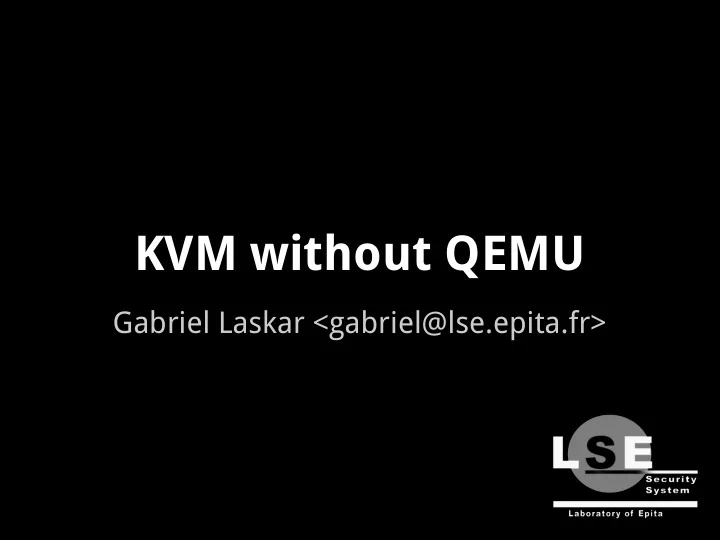

KVM without QEMU Gabriel Laskar <gabriel@lse.epita.fr>
Agenda ● What is kvm ? ● What we want to achieve ? ● kvm api overview ● how to start in 32-bit ● virtio device ● machine description ● state of the tool
What is KVM ? ● Full virtualization solution for Linux ● splitted in 2 parts : ○ Kernel module ○ Userland application ■ QEMU ■ lkvm
What are we trying to achieve ? Create a virtual machine : ● without any backward compatibility stuff ● virtio drivers ● simple access to virtualized hardware ● ...
Goals ● Simple VM for experimentation ● Thin specialized VMs ● Because we can !
Documentation It exists ! ● <linux>/Documentation/virtual/kvm/api.txt ● kvm code ● qemu code ● lkvm code
KVM API Overview ● /dev/kvm char device ● ioctls for requests ● 1 fd per resource : ○ system : vm creation, capabilities ○ vm : cpu creation, memory, irq ○ vcpu : access to state
VM Creation int fd_kvm = open("/dev/kvm", O_RDWR); int fd_vm = ioctl(fd_kvm, KVM_CREATE_VM, 0); // add space for some strange reason on intel (3 pages) ioctl(fd_vm, KVM_SET_TSS_ADDR, 0xffffffffffffd000); ioctl(fd_vm, KVM_CREATE_IRQCHIP, 0);
Add Physical Memory // set memory region void *addr = mmap(NULL, 10 * MB, PROT_READ | PROT_WRITE, MAP_ANONYMOUS | MAP_PRIVATE, -1, 0); struct kvm_userspace_memory_region region = { .slot = 0, .flags = 0, // Can be Read Only .guest_phys_addr = 0x100000, .memory_size = 10 * MB, .userspace_addr = (__u64)addr }; ioctl(fd_vm, KVM_SET_MEMORY_REGION, ®ion);
Create a VCPU and Initialisation int fd_vcpu = ioctl(fd_vm, KVM_CREATE_VCPU, 0); struct kvm_regs regs; ioctl(fd_vcpu, KVM_GET_REGS, ®s); regs.rflags = 0x02; regs.rip = 0x0100f000; ioctl(fd_vcpu, KVM_SET_REGS, ®s);
Running a VCPU int kvm_run_size = ioctl(fd_kvm, KVM_GET_VCPU_MMAP_SIZE, 0); // access to the arguments of ioctl(KVM_RUN) struct kvm_run *run_state = mmap(NULL, kvm_run_size, PROT_READ | PROT_WRITE, MAP_PRIVATE, fd_vcpu, 0); for (;;) { int res = ioctl(fd_vcpu, KVM_RUN, 0); switch (run_state->exit_reason) { // use run_state to gather informations about the exit } }
Devices : PIO switch (run_state->exit_reason) { case KVM_EXIT_IO: if (run_state->io.port == CONSOLE_PORT && run_state->io.direction == KVM_EXIT_IO_OUT) { __u64 offset = run_state->io.data_offset; __u32 size = run_state->io.size; write(STDOUT_FILENO, ( char *)run_state + offset, size); } break ; // … }
Devices : MMIO Exit reason : KVM_EXIT_MMIO struct { __u64 phys_addr; __u8 data[8]; __u32 len; __u8 is_write; } mmio;
Organisation of the VMM Guest OS VCPU0 VCPU1 IO thread thread thread Userland Process Linux Kernel
How to start in Protected Mode void vcpu_pm_mode( struct vcpu *vcpu) { struct kvm_sregs sregs; vcpu_get_sregs(vcpu, sregs); // setup basic flat model sregs.cs.base = 0x0; sregs.cs.limit = 0xffffffff; sregs.cs.g = 1; sregs.ds.base = 0x0; sregs.ds.limit = 0xffffffff; sregs.ds.g = 1; sregs.ss.base = 0x0; sregs.ss.limit = 0xffffffff; sregs.ss.g = 1; // set default operation size and stack pointer size to 32-bit sregs.cs.db = 1; sregs.ss.db = 1; // activate PM bit in cr0 sregs.cr0 |= 0x01; vcpu_set_sregs(vcpu, sregs); }
Devices ● Configuration via MMIO/PIO ● eventfd for events between host/guest ○ irqfd : host → guest ○ ioeventfd : guest → host
What is virtio ● Abstraction for virtualized devices ● spec available ● standardisation in progress ● 2 types of devices : pci or mmio ● configuration ● queues
How to advertise device configuration ? Existing standards : ● ACPI ● MP tables ● PCI ● SFI All these choices are complex, or old. Solution : create our own structure and give it to the kernel
Machine informations struct memory_map_entry { struct start_info { uint base; uint ioapic_base; uint size; uint mem_size; #define MEMORY_FLAG_READ_ONLY 1 uint mem_entries; uint flags; uint dev_size; #define MEMORY_USE_FREE 0 uint dev_entries; #define MEMORY_USE_KERNEL 1 }; #define MEMORY_USE_INIT 2 uint use; }; struct device_map_entry { uint base_addr; uint interrupt_num; };
State of the Proof of Concept ● start in PM ● load an ELF binary ● simple struct passed to describe devices ● Started Virtio mmio configuration ● Virtio queues ● virtio-rng device
Thank you ● gabriel@lse.epita.fr ● http://www.linux-kvm.org ● http://qemu.org ● https://github.com/penberg/linux-kvm ● https://github.com/rustyrussell/virtio-spec
Recommend
More recommend